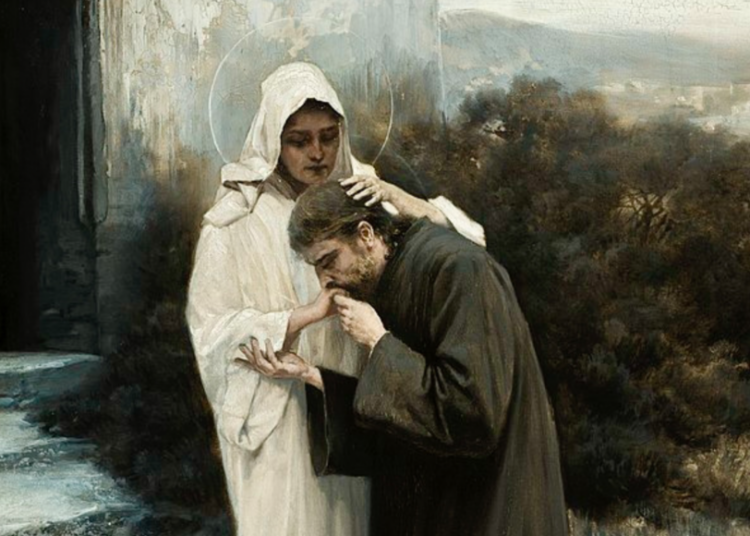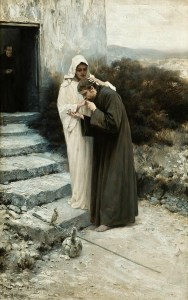One of the most astonishing aspects of the Incarnation mystery is that Christ, while being “God from God, Light from Light,” can withal be spoken of as a human being among human beings. In studying Jesus’ personality, background, concerns, and interests, we touch divinity itself, and learn something of divinity’s plan for humanity as expressed in the forms and structures that make up a civilized life.
Studying theology at university, I was particularly drawn to Christology, the study of the nature, person, and attributes of the Lord Jesus—both in his relation to the Heavenly Father and in relation to mankind. What I liked about this field was the fascinating avenues of thought it opened up onto the mystery of the divine person. For example, Christology often speculates on matters relating to Jesus’ knowledge and will. How much did he know in life, and how did he come to know it? Did he have to undergo the customary human learning process, or did he have some degree of infused knowledge—apart from the basic knowledge of his identity and mission? Did he have two wills, human and divine? If so, how did they interact? Even the most devoted student of theology must realize that, as far as we go down this road of reflection, we will never completely penetrate the mystery.
One of the most astonishing aspects of the Incarnation mystery is that Christ, while being “God from God, Light from Light,” can withal be spoken of as a human being among human beings. Ontologically Christ is both on a level with God and with Joe the Barber. We can legitimately compile volumes in which we compare Jesus to other sages or influential men of world history, precisely because he was both of these to a preeminent degree. Books from the Renaissance onward declared how Jesus exemplified the natural virtues—how could he not? Jesus’ divinity in no way lessens his humanity. And as true man, one of things the Christ had was a culture. He was born into a particular society and civilization—that of ancient Mediterranean Judaism, to be sure. He went no doubt to a particular Hebrew school where he learned particular doctrines. He felt a belonging with the history and destiny of his people. Because God entered a particular human nature, there are particularities to his personality that can be identified and studied.
What got me thinking of these things was a wonderful small volume by the late Paul Johnson, Jesus of Nazareth: A Biography from a Believer, which I have been reading this Lent. Early in the book, Johnson recalls the episode of the boy Jesus being found in the Temple among the teachers of the Law. As Johnson reminds us, this is the last we hear about Jesus until he begins his public life around the age of thirty. This great silence has quite naturally invited speculation about what Jesus did during this time, about his education and occupations. Johnson speculates freely, and fascinatingly, for the most part using internal evidence from the Gospels. Jesus, he believes, was “well instructed” even if largely self-taught. The Temple episode demonstrates that by the age of twelve he could take part in a learned discussion of the meaning of the scriptures. He could also write, as proven by his writing in the sand before the woman taken in adultery.
But Our Lord did not frequent advanced theological training, as did the rabbis and scribes. That he was an autodidact in this respect we know from John 7:15, where the Temple authorities ask, “How is it that this man has learning, when he has never studied?” Johnson makes much of this, extolling the fact that Jesus’ imagination was “unsullied by the classroom or lecture hall.” The elemental aspect of Jesus’ teaching reflected a mind that shunned “academic deformation or the impress of a system.” His doctrines about morality and life stripped away unnecessary excrescences to concentrate on the essential, the inner meaning.
This inner meaning is articulated in the highly poetic nature of his parables and sayings as reported by the evangelists, which was surely inherited from his mother (as seen in her impromptu canticle, the Magnificat). As Johnson says, “Jesus was not so much a rhetorician, or a preacher, as a poet. He thought and reasoned and spoke as a poet does—in images, flashes of insight and metaphors from the world of nature….He was the poet of virtue, the bard of righteousness, the minstrel of divine love.” Johnson makes a stunning inference from this, stating his belief that Jesus knew poetry deeply—not only the sacred poetry of the Hebrew scriptures (as found, for example, in the Book of Job and the Psalms) but also the Latin and Greek classics, and that could have recited passages from Homer or Virgil—although Johnson admits this is only “deductive supposition.” Questions have certainly been raised about Jesus’ interview with Pilate, specifically the language in which it was conducted. Greek, Latin? Was there an interpreter? Greek was widely spoken on the coast of Palestine, and a Roman governor ruled from Jerusalem. The Jewish people were surrounded by other cultures and languages, and there’s no saying that Christ was not acquainted with the gentile tongues.
Johnson stresses the critical stance—even a salutary skepticism—toward human affairs that Jesus showed time and again and which was the fruit of close scriptural reading and interpretation. But how much of this was due to his knowledge as God, how much to his human cultural formation? Again, a Christological mystery. An important question to ask, though, because while Christianity is universally acknowledged to have given risen to a great culture, few perhaps stop to think about whether Christ himself was a bearer of culture.
The evidence we have points to a “civilized, cultured, educated man who chose his words with great care and precision, with delicacy, accuracy, and tact”—an example of which, to my mind, is the following passage in his denunciation of the Pharisees: “you tithe mint and dill and cumin, and have neglected the weightier matters of the law, justice and mercy and faith; these you ought to have done, without neglecting the others” (Mt 23:23) (italics added). A corollary of this highly poetic nature, this cultured precision deriving from the close reading of sacred texts, was a neat balance of reason and emotion in Jesus’ character. He displayed, according to Johnson, “grace and skill, psychological and emotional brilliance.” His life was more a poem than the proclamation of law (even though underlying the poetry is certainly a law of love, and one may deduce laws and precepts from his imagery).
Yet this feeling for humanity fit into a template of reason and common sense; consider the episode of the woman taken in adultery, which exquisitely united compassion and logic, or similarly his attitude toward the Sabbath. I am moved by Johnson’s conviction that Jesus’ teaching emphasizes the reasonableness of truth, to the extent that such later religious structures as Aquinas’ Summa are entirely consistent with the gospel.
Contrary to common assumption, Johnson does not believe that Jesus carried on his foster father Joseph’s trade of carpentry after his death. He argues instead for him having gone abroad serving various jobs, becoming acquainted with a wide variety of people and circumstances, a school of life which would serve him in his ministry (one reason why he delayed the ministry until the age of thirty). Joseph died at some point in Jesus’ youth; his mother, Mary, it would seem, subsequently went to live with relatives—the “brethren” of Jesus referred to in the gospels—while Jesus went his own way.
That is part of the meaning of that great eighteen-year silence, and of the silence Jesus often enjoined on the recipients of his miracles. It was a question of timing; he had to establish his character as a man before he revealed the mystery of his Godhood. And the various experiences that established his identity as an adult man were made in that great silent period, between the ages of twelve and thirty.
What profession did he cultivate? Johnson believes it was for good reason that Jesus styled himself the Good Shepherd, that he literally worked as a shepherd for a time, and as a farmer too. This would explain the expert knowledge of agricultural matters and vivid feeling for nature he shows time and again in his parables and imagery, and the centrality of shepherding to his mission. Responsibility for vulnerable, wayward sheep would have given him understanding of protection and stewardship, of risk and danger, and agriculture would have yielded insight into growth and decay, pruning and cultivation, and stewardship again. Johnson even sees an echo of the shepherd’s lifestyle in Jesus’ penchant for punctuating social life with periods of solitude and prayer, often on high places.
A life of wide practical experience, then, instead of one of narrowly focused institutional training. An elemental life, close to creation, instead of an academic and legalistic life. Yet Jesus’ education, his culture and character, were ultimately founded on the sacred basis of the traditions, law, literature and poetry and hymns, the ethical and aesthetic values, the Permanent Things belonging to the chosen people. Thus, it was a true and authentic culture.
But why were no details of Jesus “secret years” recorded by the evangelists? Mary was surely an overflowing source of memories. Perhaps because not knowing all the details gives us an opportunity to exercise our imagination and preserves some degree of mystery. In any case, if believers learn all they can about the cultural particulars of Christ’s life—even if through informed conjecture—they will better know and understand the object of their worship. Because in studying Jesus’ personality, background, concerns, and interests, we touch divinity itself, and learn something of divinity’s plan for humanity as expressed in the forms and structures that make up a civilized life.
This essay was first published here in March 2023.
The Imaginative Conservative applies the principle of appreciation to the discussion of culture and politics—we approach dialogue with magnanimity rather than with mere civility. Will you help us remain a refreshing oasis in the increasingly contentious arena of modern discourse? Please consider donating now.
The featured image is “Our Lady Says Farewell to Christ” (1894) by Piotr Stachiewicz from the cycle “Legend of Our Lady,” and is in the public domain, courtesy of Wikimedia Commons.



